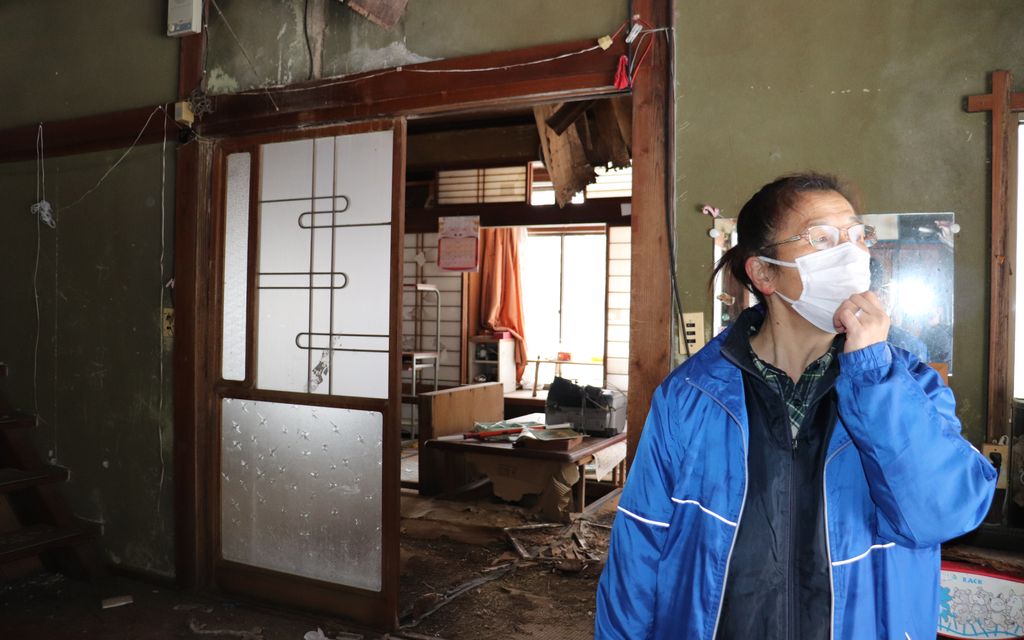On a recent snowy day, Harue Sanpei returned briefly to her abandoned house in a hilly area of Fukushima prefecture, where residents are still barred from living because of extensive radioactive contamination from Japan’s worst nuclear disaster a decade ago.
Her family’s two-story traditional wooden house has been left untouched since their evacuation, so it has huge, gaping holes in ceilings, with tatami mats caving in and mouldy chests.
Sanpei says she is heartbroken by the house, which is full of fond memories of her four-generation family of 10, being in such disorder.
She also says local residents have a profound attachment to their land – the Tsushima district in Namie Town, about 30 kilometres north-west of the crippled Fukushima Daiichi Nuclear Power Station.
“Tsushima is full of natural riches. We used to enjoy a cherry blossom viewing party together, collect edible wild vegetables and mushrooms and catch fish in a local river,” Sanpei recalls.
However, the close-knit community was ripped apart by the 2011 triple meltdown at the plant, run by Tokyo Electric Power.
The nuclear emergency was triggered by a magnitude-9 earthquake and subsequent tsunami. Then, winds sent a plume of radiation north-westward toward Tsushima.
“It is very sad that we lost our hometown because of the nuclear disaster,” says Sachiko Mashio, who used to run a restaurant in Tsushima.
“Tsushima was a healing place surrounded by mountains. We used to enjoy seeing its breathtaking autumn foliage,” Mashio says.
The Tsushima district is now designated as a “difficult to return” zone, and its residents have no idea as to when they would be able to return home.
Meanwhile, the central government once again wants to emphasize Fukushima’s “recovery” on the 10th anniversary of the nuclear disaster on Thursday. It lifted evacuation orders in many of the affected areas, including central parts of Namie Town, near the nuclear plant, allowing residents to return to their homes.
However, a vast majority of them have not done so due to few job opportunities and concerns about radioactive contamination, though government officials stressed decontamination work was completed.
“Even though the government lifted the evacuation orders, locals still cannot grow rice and vegetables. They cannot eat fish they catch in a river,” Sanpei says.
“I wonder whether Tokyo Electric employees and government officials could live there with their children and grandchildren even after the evacuation order was lifted,” she says. “I urge the government to be far more careful when they lift an evacuation order.”
Mashio and her family never considered returning to Tsushima.
Instead they settled in Hatoyama, a small town north of Tokyo, where they had no acquaintances. But local volunteers helped them become acclimatized to the place.
Mashio says that while moving more than 10 times since the disaster, her husband’s health condition deteriorated and he later died.
Like many nuclear evacuees, Mashio felt isolated, as the disaster put her far away from her friends and old neighbours.
The Covid-19 pandemic added to her isolation, especially when the area was under a coronavirus state of emergency in April and May.
“It was very hard. But I managed to overcome it,” she says.
The pandemic has also had a devastating economic toll on many victims of the nuclear disaster, civic groups say.
When looking back on her life post-evacuation, Mashio recalls being completely stressed out due to repeated relocations.
“I was so worn out I did not want to do anything,” she says.
Sanpei’s family also faced difficulties after being forced to evacuate, as her 10 family members could not stay together.
They were separated into six locations until they found a place in the city of Fukushima to live together four years later.
As of January, the number of evacuees from Fukushima stood at about 36,000, according to the Reconstruction Agency.
Critics say the actual number is far larger, as the central government and local Fukushima government have never looked into the living conditions of evacuees who were forced to scatter around the country, despite repeated requests.
“A decrease in the number of evacuees does not mean Fukushima’s recovery has proceeded,” says Ayako Oga, an executive member of a citizens group of Fukushima evacuees.
“We would like people to understand various situations evacuees are put in,” says Oga, who fled to Niigata prefecture from Okuma, which co-hosts the Fukushima plant.
“We urge the government to respond to individual circumstances,” she says.








































admin in: How the Muslim Brotherhood betrayed Saudi Arabia?
Great article with insight ...
https://www.viagrapascherfr.com/achat-sildenafil-pfizer-tarif/ in: Cross-region cooperation between anti-terrorism agencies needed
Hello there, just became aware of your blog through Google, and found ...